As of 2017, King County Metro operates the 10th largest fleet of buses in the United States, with a total of 1,540 buses.[1]
Upon taking over transit operations on January 1, 1973, Metro used buses acquired from predecessor agencies Seattle Transit System and the Metropolitan Transit Company, still painted in their original colors.[2] Metro acquired the 91-bus fleet of the Metropolitan Transit Company in December 1972 at a cost of $2.75 million.[3] The first fleet of new 40-foot (12 m) buses ordered by Metro arrived in June 1976, consisting of 145 diesel coaches manufactured by AM General.[4] In 1978, Metro became the first large transit agency in North America to introduce articulated buses to its fleet, which required some bus stops to be rebuilt to accommodate 60-foot (18 m) coaches.[5][6][7] The fleet of 151 buses were manufactured by German maker MAN as part of a bulk order with other large U.S. transit agencies.[8]
Vehicle types
In 1978, Metro was the first large transit agency to order high-capacity articulated buses (buses with a rotating joint).[9] Today, King County Metro has one of the largest articulated fleets in North America (second only to MTA New York City Transit) and articulated buses account for about 42% of the agency's fleet.[10]
In 1979, the agency ordered some of the first wheelchair lift equipped coaches in the nation,[11][12] promising a completely new level of independence for disabled residents. Early lifts were severely flawed, but by the mid-1980s the lifts were generally reliable and were ordered on all new buses. Metro's entire fleet has been wheelchair-accessible since 1999.
Metro was reluctant to adopt low-floor buses, not buying any until 2003. Low-floor coaches have slightly reduced seating capacity (because the wheelwells intrude further into the passenger compartment) which may have been a concern. Whatever the reason for the delay, Metro has now embraced low-floor buses and all new fleet additions since 2003 have been low-floor and the last high-floor buses were retired in March 2020.
Trolleys

Metro maintains a fleet of electric trolleybuses that serve 15 routes along almost 70 miles[13] of two-direction overhead wire. This is the second largest trolleybus system in the United States by ridership[14] and fleet size.[15] The trolleybuses are valued by Metro both as zero-emission vehicles,[16] and as vehicles well adapted to Seattle's hilly terrain.
Metro's trolleybus fleet consists of 174 entirely low-floor New Flyer Xcelsior coaches.[17] Of the total, 110 are 40-foot (12 m) vehicles (model XT40) and 64 are 60-foot (18 m), articulated buses (model XT60).[17] The buses include an auxiliary power unit, to allow them to operate off-wire for up to 3 miles (4.8 km).
Occasionally Metro will use diesel or diesel-electric hybrid coaches on trolley routes. Reasons for doing this include construction (weekends only),[18] overhead wire maintenance or events that require coaches to go long distances off-route, "coach changes" (replacing a bus in service that has developed a problem) or to add temporary additional capacity. The latter two cases sometimes lead to diesel buses being used, in order to get the replacement or supplementary vehicle into service as quickly as possible; diesel buses can reach the point of entry into service faster, as they do not need to follow the overhead wires when deadheading.
Diesel-electric hybrids

Metro operates the largest fleet of hybrid buses in the country. The first hybrid buses were purchased in 2004 for use with routes that operated in the Downtown Seattle Transit Tunnel.[19] The National Renewable Energy Laboratory conducted a one-year comparative study between conventional diesel and hybrid-powered buses operating on a typical King County drive cycle. Results showed that the hybrid powered buses lowered fuel consumption by 23%; NOx by 18%; carbon monoxide (CO) by 60%; and total hydrocarbon (THC) by 56% when compared to conventional diesel buses. Those results have led Metro to purchase hybrid buses exclusively since 2005 (with the exception of the all-electric trolley buses).[20][21] Metro now has over 700 hybrid buses in the fleet, with more on order.
Hush mode
Buses equipped with the GM-Allison EP50 and the Allison H 50 EP parallel hybrid systems had a special "hush mode" that allowed the buses to operate solely on electric power, reducing tailpipe emissions and noise while operating in the Downtown Seattle Transit Tunnel.[19] Before entering the tunnel, the operator pushed a button that put the coach into hush mode. While buses were inside stations, the coaches operated solely on electric propulsion (although, while the doors are closed, the engine still rotates in order to operate auxiliary loads). In between the tunnel's stations, the buses used electric traction to get to 15 mph (24 km/h), after which a combination of the electric and diesel motors were used. The operation of the diesel engine allowed the batteries to recharge. Hush mode would normally be deactivated by the operator as they exited the tunnel, but the mode will be automatically deactivated after the coach had traveled a certain distance.
Buses have not operated in the tunnel since March 23, 2019.[22]
Series hybrids

Metro's newest buses are equipped with the BAE Systems HybriDrive, a series hybrid system.[23] In these buses an electric motor turns the wheels, with power provided by a generator attached to a diesel engine and regenerative braking. Any excess power is stored in batteries on the roof of the bus. Because the diesel engine is not directly propelling the bus, it can operate at a more steady, fuel-efficient speed.
Buses delivered after 2014 are equipped with the upgraded HybriDrive Series-E which uses electrically powered accessory systems (alternator, air conditioning, air compressor, cooling fans and steering pump) to increase fuel efficiency and allow the diesel engine to stop when the bus is stopped and the batteries are sufficiently charged.
Battery electric buses
Metro began testing three new Proterra Catalyst battery electric buses in 2015.[24] The coaches are capable of traveling over 26 miles[25] before the battery needs to be recharged. A special fast charge station located at the Eastgate Park and Ride allow the bus to be fully recharged in under 10 minutes, during the driver's normally scheduled layover.[26] These new vehicles get the equivalent of 20.8 MPG, which is over 6 times better than the 3.18 MPG seen on Metro's series hybrid electric coaches.[27][28] The coaches were purchased with support from a $4.7 million Federal Transit Administration grant and entered revenue service on February 17, 2016.[29] They operate on shorter routes (due to their limited range) on the eastside, specifically Routes 226 and 241.[27][30] Metro has committed to purchasing 120 electric buses with the option to purchase up to 80 additional vehicles by 2020. In 2017 and 2018, Metro tested electric buses with ranges of 140 miles from several manufacturers,[31] and plans to have a zero-emissions bus fleet by 2040.
Historic preservation
Metro has a special fleet of more than a dozen historic motor buses and trolleybuses ranging from ones built in the late 1930s and early 1940s through to ones only recently retired. The coaches are restored, maintained and operated under an agreement with the Metro Employees Historic Vehicle Association (MEHVA), a non-profit organization formed in 1981.[32] Metro maintains ownership of the historic fleet, providing coverage under its fleet self-insurance along with storage, work space and parts on an as available basis.
Money to operate the coaches and purchase parts not in Metro stock is generated by selling tickets to public excursions. The first trips took place in 1984, and nowadays MEHVA typically operates six to eight per year.[32] Each excursion has a different route and a different emphasis.
MEHVA was established in 1981, as Metro prepared to retire trolleybuses that had been operating in Seattle since the 1940s. Since that time, MEHVA acquired other retired transit vehicles which were formerly operated in King County. Often these retired coaches were purchased by private citizens and left on the owner's property for many decades, leaving them in need of restoration. The collection of vehicles has gradually expanded over time, with the addition of newly retired buses when deemed historically notable and not yet represented in the collection.
Current fleet roster
| Make/Model | Length | Thumbnail | Propulsion | Year | Fleet Series (Quantity) |
Notes |
|---|---|---|---|---|---|---|
| New Flyer DE60LF | 60 feet (18 m) |  |
diesel-electric hybrid | 2008–2009 | 6813–6865 (53)[33] |
|
| New Flyer DE60LFA |  |
2009 | 6000–6019 (20)[33] |
| ||
| OBI Orion VII | 40 feet (12 m) |  |
2010–2012 | 7001–7199 (199)[33] |
| |
| New Flyer DE60LFR | 60 feet (18 m) |  |
2010–2013 | 6866–6999, 6800 (135)[33] |
||
 |
6020–6035, 6040–6073, 6075–6117 (93)[33] |
| ||||
| New Flyer Xcelsior XDE35 | 35 feet (11 m) | 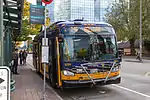 |
2014 | 3700–3759 (60) |
| |
| New Flyer Xcelsior XDE40 | 40 feet (12 m) | .jpg.webp) |
2015 | 7200–7259 (60) |
| |
| New Flyer Xcelsior XT40 | 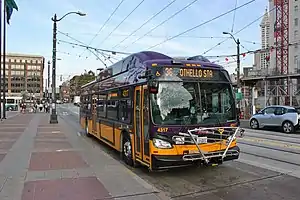 |
electric trolleybus | 2014–2015 | 4300–4409 (110) |
| |
| New Flyer Xcelsior XT60 | 60 feet (18 m) | .jpg.webp) |
2015–2016 | 4500-4563 (64) |
||
| New Flyer Xcelsior XDE60 | 60 feet (18 m) | _on_RapidRide_D.jpg.webp) |
diesel-electric hybrid | 2015 | 6200–6219 (20) |
|
| 2018 | 6220–6241 (22) |
| ||||
 |
2019 | 6242-6269 (28) |
| |||
 |
2015–2016 | 8000–8084 (85) |
| |||
| 2017–2018 | 8100–8199 (100) |
| ||||
| 2018 | 8200–8299 (100) |
| ||||
| Proterra Catalyst | 40 feet (12 m) | .jpg.webp) |
battery electric | 2015 | 4601–4603 (3) |
|
 |
2018 | 4604–4611 (8) |
||||
| Gillig Low Floor | 40 feet (12 m) |  |
diesel-electric hybrid | 2018–2019 | 7300–7494 (195) |
|
| New Flyer Xcelsior XE40 | 40 feet (12 m) | 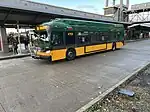 |
battery electric | 2021 | 4700-4759 (60) |
|
| New Flyer Xcelsior XE60 | 60 feet (18 m) | 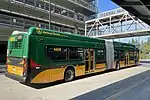 |
4800–4839 (40) |
Future fleet
| Make/Model | Length | Propulsion | Year | Quantity | Notes |
|---|---|---|---|---|---|
| Proterra Catalyst BE40 | 40 feet (12 m) | battery electric | 2019 | 4612–4623 (12) |
|
| New Flyer XE60 Xcelsior CHARGE | 60 feet (18 m) | 2022 | 4840–4859 (20) |
[43] | |
| TBA | 4860–4879 (20) |
[44] | |||
| New Flyer Xcelsior XDE60 | diesel-electric hybrid | 2024 | 6400–6412 (13) |
|
Historic fleet
These historic buses are owned by King County Metro, but are restored, maintained and operated by unpaid volunteers who are in the Metro Employee Historic Vehicle Association (MEHVA).
| Make/Model | Length | Thumbnail | Propulsion | Year | Purchasing Agency | Fleet Number |
|---|---|---|---|---|---|---|
| Kenworth H-30 | Diesel | 1938 | Seattle Municipal Street Railway | 1705 | ||
| Twin Coach 30-G | 1939 | Seattle Transit System | 231 | |||
| Twin Coach GWFT | 40 feet |  |
Electric trolleybus | 1940 | 905 (its original number when built; renumbered from 643 in 2018)[46] | |
| PCF-Brill 40 SMT |  |
798 | ||||
| Twin Coach 44 GTT | 1943 | 636 | ||||
| Pullman-Standard 41CA-100-44CX |  |
1944 | 1005 | |||
| Kenworth K-10 | Diesel | 1947 | Suburban Transit System | 86 | ||
| Twin Coach 41-S | 1948 | Seattle Transit System | 1705 | |||
| General Motors TDH-5105 | 40 feet |  |
1955 | 263 | ||
| General Motors TDH-4512 | 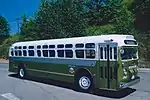 |
1959 | Metropolitan Transit Corporation | 2962 | ||
| Flxible New Look F2D6V-401-1 |  |
1963 | Seattle Transit System | 598 | ||
| General Motors New Look T8H-5305 | .jpg.webp) |
1968 | 724 | |||
| AM General Metropolitan 10240B |  |
1976 | Municipality of Metropolitan Seattle | 1122 | ||
| AM General Metropolitan 10240T |  |
Electric trolleybus | 1979 | 1008 | ||
| MAN/AM General SG 220-18-2 | 60 feet |  |
Diesel | 1978 | 1455 | |
| Flyer D900 D10240C | 40 feet |  |
1979 | 1657 | ||
| MAN Americana SL40102L | 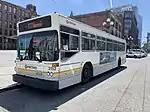 |
1987 | 3152 | |||
| Breda DuoBus 350 (ADPB 350) |
60 feet | 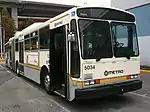 |
Dual-mode (diesel & electric trolley) |
1990 | 5034 | |
| Gillig Phantom 40102TBM11 | 40 feet |  |
Diesel | 1997 | King County Metro | 3374 |
| Gillig Phantom C28D102N4 |  |
Electric trolleybus | 2002 | 4195 | ||
| New Flyer DE60LF | 60 feet | 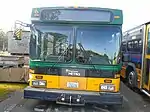 |
Diesel-Electric Hybrid | 2004 | 2766 |
In addition, No. 4020, one of the MAN SG-T 310 articulated trolleybuses, was donated to and preserved at the Illinois Railway Museum (IRM) in 2008 through the efforts of MEHVA. It was part of the first fleet of articulated trolleybuses to operate in America.[47]
Retired fleet
- See Trolleybuses in Seattle for a detailed history of Seattle's trolleybus fleet.
| Make/Model | Length | Thumbnail | Propulsion | Motor/Powertrain) | Purchased | Retired | Fleet Series (Qty.) | Seated Capacity | Notes |
|---|---|---|---|---|---|---|---|---|---|
| Brill trolley | 40' |  |
Electric trolleybus | GE | 1940 | 1963 | 700–799 (100) |
40 | |
| Twin Coach trolley |  |
Westinghouse | 1978 | 800–976 originally 600–659 after 1974 (177) |
41 | Original series of 800–976 included 24 slightly larger units, built in 1943; remaining coaches renumbered in 1974. No. 905 preserved by Metro (initially preserved as No. 643 from 1982–2018, then reverted to original No. 905).[46] | |||
| Pullman-Standard trolley |  |
GE | 1944 | 977–1006 originally 642–655 after 1974 (30) |
44 | Remaining coaches after some retirements were renumbered in 1974. No. 1005 preserved by Metro. | |||
| GMC TDH-5105 |  |
Diesel | 1955 | 1982 | 200–304 (105) |
51 | No. 263 has been preserved by Metro.[48] | ||
| Flxible "New Look" |  |
Detroit Diesel 6V71 | 1963 | 1986[49] | 500-599 (100)[49] |
No. 598 has been preserved.[48] | |||
| GMC "New Look" T8H-5305 |  |
Detroit Diesel 8V71N / Allison VS2-8 | 1968 | 1987 | 700-769 (70) |
48 | |||
| AMG "Metropolitan" 10240B8 | Detroit Diesel 8V71N / Allison V730 | 1976 | 1996 | 1100–1313 (214) |
45 | ||||
| Detroit Diesel 8V71T / Allison V730 | 1340-1349 (10) | ||||||||
| MAN SG-220 | 60' |  |
MAN D2566 MLUM / Renk-Doromat 874B | 1978–1979 | 1999 | 1400-1550 (151) |
72 | ||
| Flyer D900 | 40' |  |
Cummins VTB903/ Allison V730 | 1979 | 1997 | 1600-1823 (224) |
47 | ||
| AMG 10240T | 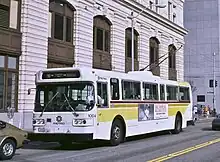 |
Electric trolleybus | GE | 2003 | 900-1009 (109) |
45 | No. 911 not used.[50] | ||
| Flyer D900 | 35' | Diesel | Cummins VTB903 / Allison V730 | 1980 | 1997 | 1850-1884 (35) |
39 | ||
| MAN SG-310 | 60' |  |
MAN D2566 MLUM/ Renk-Doromat 874B | 1982–1983 | 2001 | 2000-2201 (202) |
70 | ||
| MAN Americana | 40' |  |
1986–1987 | 2004 | 3000-3146 3150-3159 (157)[51] |
44 | |||
| MAN SG-T 310 | 60' |  |
Electric trolleybus | Siemens[52][53] | 1987 | 2007 | 4000-4045 (46)[54] |
64 | |
| Breda DuoBus 350 (ADPB 350) |
 |
Dual-mode (diesel & electric trolley) | Diesel: Detroit Diesel 6V92TA / ZF 4HP600 Electric Trolley: AEG / Westinghouse |
1988–1991 | 2005 | 5000–5235 (236) |
63 | ||
 |
Electric trolleybus conversion | AEG/Westinghouse | 1988–1991 (converted 2004–2007) | 2016 | 4200–4258 (59)[55] |
56 | Last Breda trolleybus to be retired was unit 4243 on route 36 on October 27, 2016 | ||
| Gillig Phantom | 35' |  |
Diesel | Cummins M11 / Allison B400R Gen III | 1997 | 2015 | 3185-3199 (13)[56] |
34 | |
| New Flyer D60HF | 60' |  |
1998–1999 | 2018 | 2300–2573 (274)[57] |
64 | |||
| Gillig Phantom | 40' |  |
Electric trolleybus | GE (refurbished by Alstom) | 2002 | 2016 | 4100–4199 (100)[58] |
42 | |
| New Flyer D60LF | 60' | 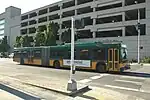 |
Diesel | Caterpillar C9 / Allison B500R Gen IV | 2004 | 2018 | 2870–2899 (30)[59] |
56 | |
| StarTrans President LF | 28' | 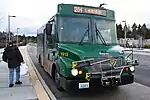 |
GMC/Duramax Allison 1000 series | 2009 | 2013 | 1900-1934 (35) |
19 | Retired due to design flaws[60] | |
| Gillig Phantom | 40' | 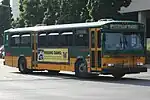 |
Cummins M11/Allison WB-400R | 1996–1999 | 2019 | 3200-3594 (395) |
42 |
| |
| 30' | 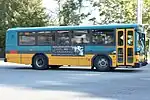 |
Cummins ISC/Allison WB-400R | 1999-2000 | 2020 | 1100–1194 (95) |
30 | Last 4 coaches in service were 1104 and 1127 on Route 200, 1114 on Route 236/238 on March 20, 2020, and 1187 on Route 200 on March 10, 2020. | ||
| New Flyer D40LF | 40' | 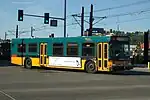 |
Diesel | Cummins ISL/Voith 864.3 | 2003 | 3600-3699 (100) |
35 | Last two coaches to be retired were 3660 and 3680 on route 65/67 on April 8, 2020. | |
| Proterra Catalyst BE40 | .jpg.webp) |
Battery Electric | UQM HD220 / Eaton EEV-7202 | 2019 | 1750-1751 (2) |
38 |
| ||
| XE40 Xcelsior CHARGE |  |
Siemens ELFA2 | 2018 | 1752-1753 (2) |
| ||||
| XE60 Xcelsior CHARGE | 60' | .jpg.webp) |
1754-1755 (2) |
49 |
| ||||
| BYD K9 | 40' |  |
BYD TYC90A | 1756-1757 (2) |
38 | Test buses | |||
| BYD K11M | 60' | .jpg.webp) |
1758-1759 (2) |
Test buses | |||||
| New Flyer DE60LF | 60' |  |
Diesel-Electric Hybrid | Caterpillar C9 / Allison EP50 | 2004 | 2021 | 2600-2812 (213) |
56 | Last coach active was 2807 on route 372 operating toward Woodinville, making its final stop at Campus Way N.E. at approximately 12:28 A.M. on December 11, 2021. |
See also
References
- ↑ Roman, Alex (September 25, 2017) [print edition of September–October 2017, pp. 28]. "2017 Top 100 Transit Bus Fleets Survey" (PDF). Metro Magazine. Retrieved September 26, 2017.
- ↑ "Metro OK's contracts with two transit lines". The Seattle Times. December 8, 1972. p. E7.
- ↑ Lane, Bob (December 1, 1972). "One query asked at Metro bus hearing". The Seattle Times. p. A15.
- ↑ Lane, Bob (June 2, 1976). "New buses're here—with quite a difference". The Seattle Times. p. C1.
- ↑ Oldham, Kit (June 18, 2006). "Metro: Municipality of Metropolitan Seattle". HistoryLink. Retrieved January 24, 2018.
- ↑ Lane, Bob (August 14, 1978). "Bending buses, new lanes pass first test". The Seattle Times. p. A14.
- ↑ Anderson, Ross (August 1, 1978). "Rush-hour bus lanes OK'd for downtown". The Seattle Times. p. A14.
- ↑ "Shipping on U.S. vessels with increase cost of Metro buses". The Seattle Times. October 6, 1978. p. C8.
- ↑ Oldham, Kit (June 18, 2006). "Metro: Municipality of Metropolitan Seattle". HistoryLink. Retrieved January 20, 2014.
- ↑ King County Metro (October 2013). "2012 Annual Management Report" (PDF). Archived from the original (PDF) on October 7, 2014. Retrieved September 30, 2014.
- ↑ Voris, Michael. "The evolution of Metro buses - video transcript". Metro Online. King County Metro. Retrieved January 20, 2014.
- ↑ Crowley, Walt (1993). Routes: an interpretive history of public transportation in metropolitan Seattle. Seattle: Crowley Associates. pp. 2, 3.
- ↑ "Facts". King County Metro. April 16, 2009. Retrieved July 9, 2009.
- ↑ "APTA Ridership Report: First Quarter 2009 - Trolleybus Agencies" (PDF). Public Transportation Ridership Statistics. American Public Transportation Association. June 8, 2009. Retrieved November 17, 2009.
- ↑ Webb, Mary (Ed.) (2009). Jane's Urban Transport Systems 2009-2010. Coulsdon, Surrey (UK): Jane's Information Group. ISBN 978-0-7106-2903-6.
- ↑ Metro Vehicles King County Metro.
- 1 2 "King County launches next generation of electric trolleys and previews new battery-powered bus". King County Metro. August 18, 2015. Retrieved May 3, 2016.
- ↑ "Trolley buses". King County Metro. December 5, 2008. Retrieved August 5, 2009.
- 1 2 Chandler, K; K. Walkowicz (December 2006). "King County Metro Transit Hybrid Articulated Buses: Final Evaluation Results" (PDF). National Renewable Energy Laboratory. Archived from the original (PDF) on May 8, 2009. Retrieved July 16, 2009.
- ↑ "New Flyer Receives Order for Up To 715 Buses From King County Metro Totaling Up To US $514 Million" Archived September 30, 2011, at the Wayback Machine
- ↑ "Federal stimulus grant delivers more buses for Metro". Auburn Reporter. July 14, 2009. Archived from the original on February 1, 2013. Retrieved August 8, 2009.
- ↑ Switzer, Jeff (March 21, 2019). "'The Last Dance:' Metro buses say goodbye to Downtown Seattle Transit Tunnel". Metro Matters. King County Metro. Retrieved March 16, 2021.
- 1 2 3 Piellisch, Rich (February 12, 2013). "New Flyer Hybrids for Seattle". Fleets and Fuels. Archived from the original on August 8, 2014. Retrieved August 4, 2014.
- ↑ Constantine, Dow (August 18, 2015). "King County launches next generation of electric trolleys and previews new battery-powered bus". King County Metro. Retrieved March 13, 2016.
- ↑ Proterra (July 2014). "Proterra Specifications" (PDF). Archived from the original (PDF) on September 3, 2014. Retrieved August 29, 2014.
- ↑ Proterra. "Proterra FAQ". Archived from the original on September 3, 2014. Retrieved August 29, 2014.
...fast-charge, which allows the bus to charge in less than 10 minutes during regularly scheduled stops but requires more frequent charging.
- 1 2 "Metro to test battery-electric buses" (PDF). King County Metro. Summer 2015. Retrieved March 13, 2016.
- ↑ Ranganathan, Shefali (March 2007). "Hybrid buses costs and benefits" (PDF). Environmental and Energy Study Institute. Retrieved March 13, 2016.
- ↑ "Executive Constantine launches Metro Transit's first all-electric battery-powered bus" (Press release). King County Metro. February 17, 2016. Retrieved February 17, 2016.
- ↑ Constantine, Dow (February 17, 2016). "King County Metro Transit launches first all-electric battery-powered bus". King County Metro. Retrieved December 7, 2018.
- ↑ Constantine, Dow (November 20, 2018). "King County Metro will test long-range battery-powered buses that can travel more than 140 miles on a single charge". King County Metro. Retrieved December 7, 2018.
- 1 2 Tan, Vinh (October 15, 2009). "Take a ride down memory lane — or to see fall foliage — aboard a vintage transit bus". The Seattle Times. Retrieved June 16, 2010.
- 1 2 3 4 5 "King County Metro Transit". Canadian Public Transit Discussion Board. Retrieved 8 June 2014.
- ↑ "Metro to partner with New Flyer on next generation of electric trolley buses". King County Metro. Retrieved 24 February 2014.
- ↑ "King County Metro Transit 6242-6269". Canadian Public Transit Discussion Board. Retrieved September 15, 2019.
- ↑ "New Flyer Celebrates Delivery of 10,000th Xcelsior Bus and Evolution in Transit Innovation - New Flyer | North America's Bus Leader". New Flyer | North America's Bus Leader. 2018-05-22. Retrieved 2018-05-25.
- ↑ Proterra. "Proterra Specifications" (PDF). Archived from the original (PDF) on 3 September 2014. Retrieved 29 August 2014.
- ↑ Proterra. "Proterra FAQ". Archived from the original on 3 September 2014. Retrieved 29 August 2014.
...fast-charge, which allows the bus to charge in less than 10 minutes during regularly scheduled stops but requires more frequent charging.
- ↑ Sanders, Al (October 11, 2021). "Metro's green fleet grows with delivery of 40-foot battery-electric bus". Metro Matters. Retrieved October 22, 2021.
- ↑ Sanders, Al (March 30, 2022). "Charged up and ready to go! Metro's battery bus fleet celebrates opening of charging facility and beginning of battery-electric bus service". Metro Matters. Retrieved October 23, 2022.
- ↑ Sanders, Al (April 6, 2021). "A green arrival for Metro". King County Metro Blog. Retrieved April 16, 2021.
- ↑ Sanders, Al (March 30, 2022). "Charged up and ready to go! Metro's battery bus fleet celebrates opening of charging facility and beginning of battery-electric bus service". Metro Matters. Retrieved October 23, 2022.
- ↑ "Executive Constantine announces purchase of up to 120 battery-electric buses from New Flyer of America, Inc". King County. January 30, 2020. Retrieved February 2, 2020.
- ↑ Mercure, Matthew (February 3, 2021). "King County Metro Awards New Flyer Battery-Electric Bus Contract". NGT News. Retrieved April 16, 2021.
- ↑ Lindblom, Mike (August 27, 2018). "An uphill battle to get electric trolleybuses on Madison RapidRide route". The Seattle Times. Retrieved April 16, 2021.
- 1 2 Trolleybus Magazine (UK) No. 342 (November–December 2018), p. 235. ISSN 0266-7452
- ↑ "M-A-N 1987 King County Metro 4020". Illinois Railway Museum. Retrieved 11 March 2022.
- 1 2 "Our Fleet". Metro Employees Historic Vehicle Association. Retrieved November 4, 2014.
- 1 2 "Seattle Transit System 598". Metro Employees Historic Vehicle Association. Retrieved November 18, 2012.
- ↑ "Metro 1008". Metro Employees Historic Vehicle Association. Retrieved November 4, 2014.
- ↑ "MAN Standard Diesel Bus". King County Department of Transportation. 2003-05-28. Retrieved 2006-07-20.
- ↑ Trolleybus Magazine (UK) No. 141 (May–June 1985), p. 72. ISSN 0266-7452.
- ↑ Bushell, Chris (ed.) (1994). Jane's Urban Transport Systems 1994–95, p. 539. Coulsdon, Surrey (UK): Jane's Information Group. ISBN 0-7106-1156-0.
- ↑ "Retired - MAN Articulated Trolley Bus". King County Department of Transportation. Retrieved 2012-11-19.
- ↑ King County Metro. "Breda Articulated Trolley Bus". metro.kingcounty.gov. Archived from the original on October 7, 2014. Retrieved December 29, 2013.
- ↑ King County Metro. "Gillig Standard Diesel Bus". metro.kingcounty.gov. Retrieved December 29, 2013.
- ↑ King County Metro. "New Flyer Articulated Diesel Bus". metro.kingcounty.gov. Retrieved December 29, 2013.
- ↑ King County Metro. "Gillig Trolley Bus". metro.kingcounty.gov. Archived from the original on August 8, 2009. Retrieved December 29, 2013.
- ↑ King County Metro. "New Flyer Articulated Low Floor Bus". metro.kingcounty.gov. Retrieved December 29, 2013.
- ↑ Lindblom, Mike (October 26, 2013). "Metro gets $4.7M settlement over unwanted buses". The Seattle Times. Retrieved July 17, 2020.
External links
- Metro Vehicles page on King County Metro website